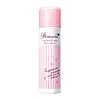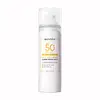What's inside
What's inside
 Key Ingredients
Key Ingredients

 Benefits
Benefits

 Concerns
Concerns

 Ingredients Side-by-side
Ingredients Side-by-side

Isododecane
EmollientNeopentyl Glycol Diethylhexanoate
EmollientEthylhexyl Methoxycinnamate
UV AbsorberVinyl Dimethicone/Methicone Silsesquioxane Crosspolymer
Alcohol
AntimicrobialHydrolyzed Hyaluronic Acid
HumectantHydrolyzed Collagen
EmollientTrisodium Ascorbyl Palmitate Phosphate
AntioxidantCeramide NP
Skin ConditioningSerine
MaskingUbiquinone
AntioxidantRoyal Jelly Extract
Skin ConditioningHibiscus Sabdariffa Flower Extract
Skin ConditioningPunica Granatum Fruit Extract
AntioxidantChamomilla Recutita Flower Extract
MaskingRaffinose
Skin ConditioningSilica
AbrasiveStearyl Glycyrrhetinate
Skin ConditioningBis-Ethylhexyloxyphenol Methoxyphenyl Triazine
Skin ConditioningDiethylamino Hydroxybenzoyl Hexyl Benzoate
UV FilterPPG-12/Smdi Copolymer
EmollientVp/Eicosene Copolymer
PEG/PPG-19/19 Dimethicone
EmulsifyingEthylhexyl Triazone
UV AbsorberPropylene Glycol Dicaprate
EmollientCaprylic/Capric Triglyceride
MaskingHydrogenated Poly(C6-20 Olefin)
AbrasiveCyclopentasiloxane
EmollientSilica Dimethyl Silylate
EmollientHdi/Trimethylol Hexyllactone Crosspolymer
Octocrylene
UV AbsorberButylene Glycol
HumectantGlycerin
HumectantWater
Skin ConditioningParfum
MaskingIsododecane, Neopentyl Glycol Diethylhexanoate, Ethylhexyl Methoxycinnamate, Vinyl Dimethicone/Methicone Silsesquioxane Crosspolymer, Alcohol, Hydrolyzed Hyaluronic Acid, Hydrolyzed Collagen, Trisodium Ascorbyl Palmitate Phosphate, Ceramide NP, Serine, Ubiquinone, Royal Jelly Extract, Hibiscus Sabdariffa Flower Extract, Punica Granatum Fruit Extract, Chamomilla Recutita Flower Extract, Raffinose, Silica, Stearyl Glycyrrhetinate, Bis-Ethylhexyloxyphenol Methoxyphenyl Triazine, Diethylamino Hydroxybenzoyl Hexyl Benzoate, PPG-12/Smdi Copolymer, Vp/Eicosene Copolymer, PEG/PPG-19/19 Dimethicone, Ethylhexyl Triazone, Propylene Glycol Dicaprate, Caprylic/Capric Triglyceride, Hydrogenated Poly(C6-20 Olefin), Cyclopentasiloxane, Silica Dimethyl Silylate, Hdi/Trimethylol Hexyllactone Crosspolymer, Octocrylene, Butylene Glycol, Glycerin, Water, Parfum
Butane
Propane
Isobutane
Isododecane
EmollientWater
Skin ConditioningDisiloxane
Skin ConditioningDimethicone
EmollientEthylhexyl Methoxycinnamate
UV AbsorberEthylhexyl Salicylate
UV AbsorberDiethylamino Hydroxybenzoyl Hexyl Benzoate
UV FilterMenthyl Lactate
MaskingEthylhexyl Triazone
UV AbsorberSilica
AbrasiveMethyl Methacrylate Crosspolymer
Silica Dimethyl Silylate
EmollientMethicone
EmollientHamamelis Virginiana Water
AstringentMethylparaben
PreservativeAroma
Ethylhexylglycerin
Skin ConditioningPropanediol
SolventPiper Methysticum Leaf/Root/Stem Extract
Skin ConditioningCentella Asiatica Extract
CleansingScutellaria Baicalensis Root Extract
AstringentPortulaca Oleracea Extract
Skin ConditioningPhenoxyethanol
PreservativeCeramide EOP
Skin ConditioningCeramide Ns
Skin ConditioningCeramide NP
Skin ConditioningCeramide As
Skin ConditioningCeramide AP
Skin ConditioningBifida Ferment Lysate
Skin ConditioningPentylene Glycol
Skin ConditioningDiethoxydiglycol
Solvent1,2-Hexanediol
Skin ConditioningPvp
Emulsion StabilisingChlorphenesin
AntimicrobialDisodium EDTA
BHT
AntioxidantButane, Propane, Isobutane, Isododecane, Water, Disiloxane, Dimethicone, Ethylhexyl Methoxycinnamate, Ethylhexyl Salicylate, Diethylamino Hydroxybenzoyl Hexyl Benzoate, Menthyl Lactate, Ethylhexyl Triazone, Silica, Methyl Methacrylate Crosspolymer, Silica Dimethyl Silylate, Methicone, Hamamelis Virginiana Water, Methylparaben, Aroma, Ethylhexylglycerin, Propanediol, Piper Methysticum Leaf/Root/Stem Extract, Centella Asiatica Extract, Scutellaria Baicalensis Root Extract, Portulaca Oleracea Extract, Phenoxyethanol, Ceramide EOP, Ceramide Ns, Ceramide NP, Ceramide As, Ceramide AP, Bifida Ferment Lysate, Pentylene Glycol, Diethoxydiglycol, 1,2-Hexanediol, Pvp, Chlorphenesin, Disodium EDTA, BHT
 Reviews
Reviews

Ingredients Explained
These ingredients are found in both products.
Ingredients higher up in an ingredient list are typically present in a larger amount.
Ceramide NP is a type of ceramide and formally known as ceramide 3.
Ceramides are intercellular lipids naturally found in our skin that bonds dead skin cells together to create a barrier. They are known for their ability to hold water and thus are a great ingredient for dry skin.
Ceramides are an important building block for our skin barrier. A stronger barrier helps the skin look more firm and hydrated. By bolstering the skin ceramides act as a barrier against irritating ingredients. This can help with inflammation as well.
If you would like to eat ceramides, sweet potatoes contain a small amount.
Read more about other common types of ceramides here:
Ceramide AP
Ceramide EOP
Diethylamino Hydroxybenzoyl Hexyl Benzoate (DHHB) is a chemical UV-A absorber. It is formulated for high UVA protection (320-400 nm).
DHHB is well-liked for:
DHHB has been approved by the EU, Japan, Taiwan, and South America for use up to 10%. Unfortunately, it has not been approved for use in the US or Canada due to slow regulatory processes.
This ingredient is soluble in oils, fats, and lipids.
Learn more about Diethylamino Hydroxybenzoyl Hexyl BenzoateEthylhexyl Methoxycinnamate is an organic compound that provides UVB protection. It often goes by the more common name of octinoxate. It is created from methoxycinnamic acid and 2-ethylhexanol.
Ethylhexyl Methoxycinnamate absorbs UVB rays with wavelengths between 280-320 nm. UV absorbers protect your skin by using chemical reactions to convert UV rays into heat and energy.
UVB (290-320 nm) rays emit more energy than UVA rays. They are capable of damaging DNA, causing sunburns and are thought to be linked to skin cancer.
The state of Hawaii has banned sunscreens containing octinoxate due to its potential impact on coral reefs. More research is needed to bridge gaps in this research. The European Union allows higher levels of octinoxate in sunscreens than the US and Australia.
Ethylhexyl Methoxycinnamate is oil soluble. It is not stable and may lose efficacy when exposed to sunlight.
Learn more about Ethylhexyl MethoxycinnamateEthylhexyl Triazone is a modern chemical sunscreen that protects from UV-B radiation.
It is the most effective of existing UV-B filters, as it provides the highest level of photo-stable absorption. It protects from the entire UV-B range (280 to 320nm), with it's highest level of protection at 314nm.
Ethylhexyl Triazone is oil soluble, oderless and colorless, which mean it is able to be incorporated into a variety of different formulations.
It is not currently available within the United States due to slow changing FDA regulations. Outside of the US, it is used in formulations at concentrations up to 5%.
Learn more about Ethylhexyl TriazoneIsododecane is a fragrance, emollient, and solvent.
As an emollient, it helps your skin stay soft and hydrated. Emollients help trap moisture into your skin.
Isododecane's role as a solvent makes it a great texture enhancer. It spreads smoothly on skin and does not leave a sticky feeling behind. Isododecane also helps prevent color transfer in makeup products.
Isododecane is not absorbed into skin.
Learn more about IsododecaneSilica, also known as silicon dioxide, is a naturally occurring mineral. It is used as a fine, spherical, and porous powder in cosmetics.
Though it has exfoliant properties, the function of silica varies depending on the product.
The unique structure of silica enhances the spreadability and adds smoothness, making it a great texture enhancer.
It is also used as an active carrier, emulsifier, and mattifier due to its ability to absorb excess oil.
In some products, tiny microneedles called spicules are made from silica or hydrolyzed sponge. When you rub them in, they lightly polish away dead skin layers and enhance the penetration of active ingredients.
Learn more about SilicaThis silica is mainly used to thicken oils and suspend particles in oils. It is not water soluble.
According to the manufacturer, it:
The manufacturer also claims this ingredient to be useful in makeup.
In lipstick formulations, this ingredient improves color payoff, reduces pigment settling, and reduces oil bleeding. This ingredient also improves the grip of powder products such as dry shampoos.
Learn more about Silica Dimethyl SilylateWater. It's the most common cosmetic ingredient of all. You'll usually see it at the top of ingredient lists, meaning that it makes up the largest part of the product.
So why is it so popular? Water most often acts as a solvent - this means that it helps dissolve other ingredients into the formulation.
You'll also recognize water as that liquid we all need to stay alive. If you see this, drink a glass of water. Stay hydrated!
Learn more about Water